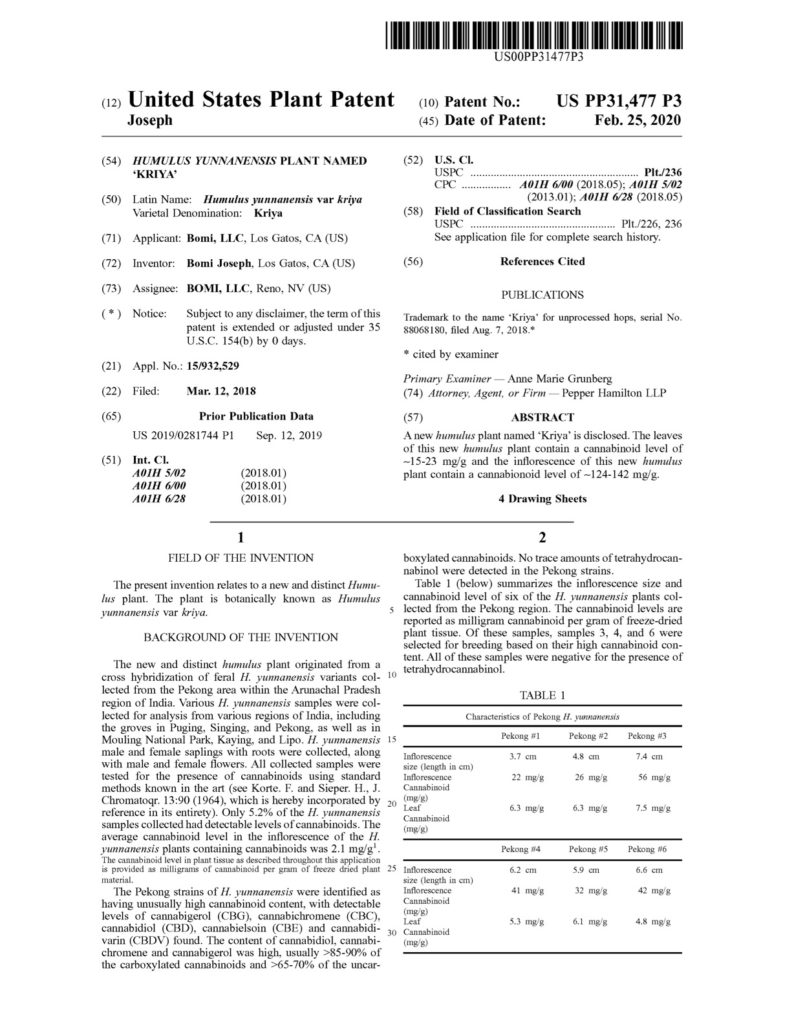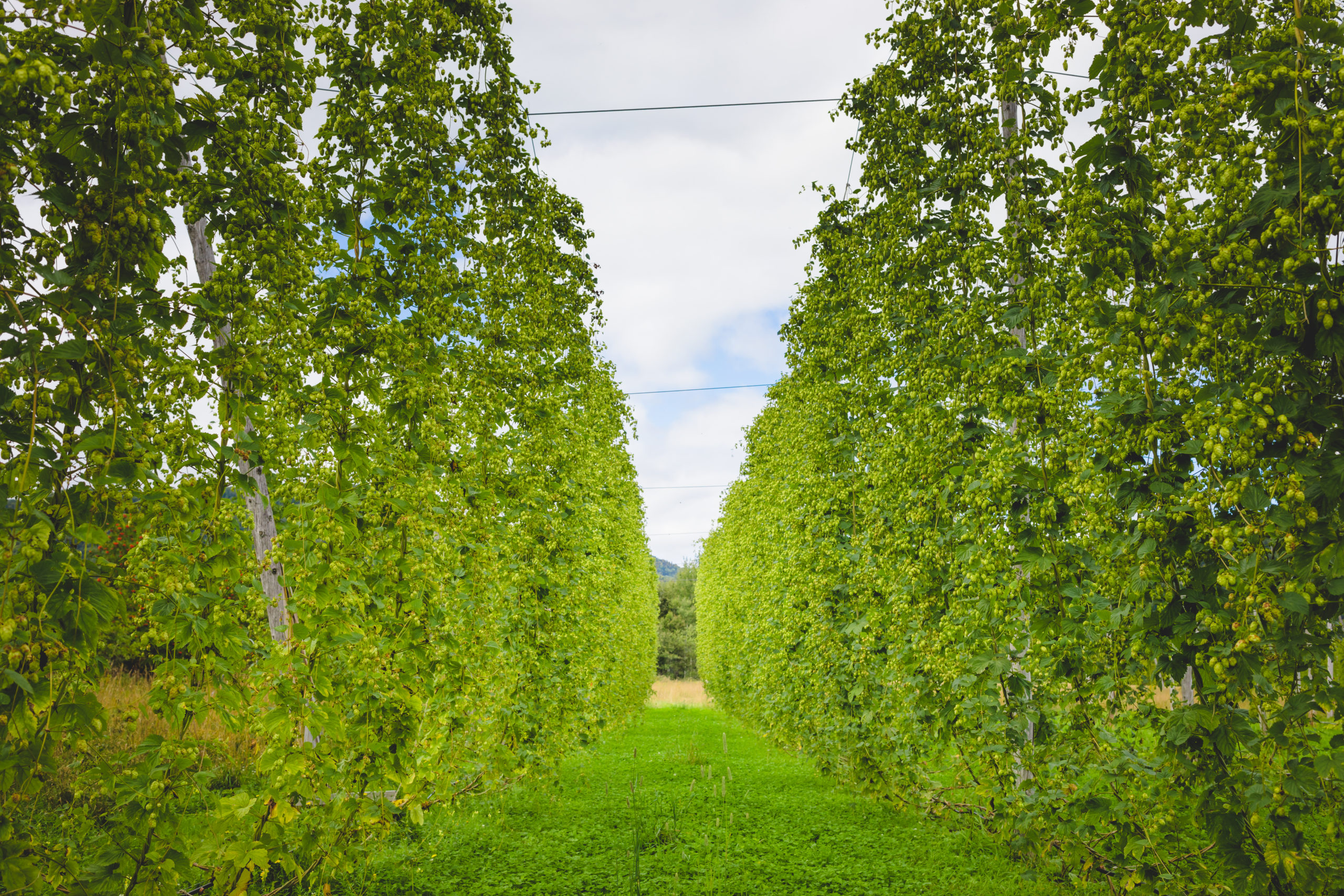
Kriya® Hops and CBD
The Kriya® brand Hops plant is the only non cannabis plant that expresses CBD (Cannabidiol.) In this article we examine the origin of the Hops plant and why this is not very surprising.
The Cannabaceae
Cannabaceae2,3 includes the species Cannabis (Hemp, marijuana), Humulus (Hops) and Celtis (Hackberries.) Celtis is the largest of the three, having more than 100 species. Cannabis and Hops have three predominant species.
Hops is a close cousin to cannabis4,5. In the wild, cross pollination and heterogeneity is the order. In mass agriculture, sterile homogenous crops are propagated through tissue culture.
Origin of Hops
‘Ale’ is the original drink of the Anglo-Saxons and the British. Ale is brewed from malt, without the addition of “hops.” ‘Beer’ is a brew made with the addition of hops. The earliest known Hops cultivations were in the Low Countries of Europe (modern Belgium and Holland) in the 15th century.
However, these hops plants were not native to Europe. They were brought to Europe from the Silk Road Region (India China border) by the Dutch and the Portuguese traders. The Hops that the European traders brought were the Humulus yunnanensis species. The Asian Hops were extensively modified to obtain the “Hops” flavor. So much so that today, all the Hops plants that are found in USA, and Europe, are tissue cultured clones that look very different from the parent plant. Todays plants are sterile, and optimized for their production of ‘lupulin’. Lupulin gives beer its characteristic flavor.
The original Hops plant was very hardy, grew rapidly and engulfed other neighboring plants. Their cones were larger. After the current Hops were optimized and cloned, they became sterile and frail. The plant hardly grew horizontally. The stalk became quite weak and frail. The lupulin Hops have to have strong strings supporting them to grow.
Indian Take On Hops
In India, the Ayurvedic Pharmacopoeia1 recommended Hops to treat restlessness associated with nervous tension, headache and indigestion. The historical association between Hops and Cannabis goes back thousands of years. The Unani word for Hops is “Hashish-Ut-Dinaar”. The literal translation of Hops in India is “The hashish that is worth its weight in gold”. It is not clear if they misidentified cannabis strains for Hops. Or if Hops-Cannabis hybrids existed with high levels of THC.
Chinese Take On Hops
“The hop plants are thought to have originated in China because China is the only country in the world where all three species of hops are found”
Jeffrey Boutain
Tracking Down Feral Hops
Jeffrey Boutain wrote a blog a couple of years after the author, Bomi Joseph, had trekked his way through the desolate India China border region, collecting feral Hops plants. Dr. Boutain stated he had studied 860 DNA tissue samples of Humulus yunnanensis (from China) and compared them to 150 Humulus lupulus samples from USA. It is apparent from his study that Humulus lupulus originated from Humulus yunnanensis and the correct nomenclature of Humulus lupulus should be Humulus yunnanensis var lupulus.
Patenting Kriya® brand Hops
Bomi Joseph cross bred his feral Hops plants for a few years, and applied for a USA patent for the Kriya® Hops plant. He was granted the patent (Patent# US PP31,477 P3) in Feb 2020.


The Significance Of Kriya® brand Hops
The significance of the patented Kriya® cultivar of Asian hops is that it is the only non cannabis plant that contains high levels of natural, non-psychotropic cannabinoid CBD, and more than 24 medicinal terpenes such as β-Caryophyllene & ⍺-Humulene. The plant naturally contains zero THC; not even in the smallest trace amounts.
Cannabidiol (CBD) from hemp (Cannabis sativa) is one of the hottest supplements on the market. But not everyone is comfortable with hemp, because it is a cannabis species, nor can access it legally federally. That’s just one reason we are excited about a breakthrough discovery: a 100% natural, botanical CBD supplement made exclusively from hops.
One of the extracts of the Kriya® Hops plant is ‘ImmunAG’. It is a cannabinoid-rich extract of the Kriya® brand Hops pod, rich in the cannabinoids, β-Caryophyllene, ⍺-Humulene and CBD (Cannabidiol). ImmunAG™ was first certified as a ‘Food Ingredient’ by the Indian Government (FSSAI# 10018025000320) in 2017. Since then, multiple governments around the world have certified Kriya® Hops for use as a food ingredient.
In addition to its novelty as the only non cannabis plant to express CBD, the Kriya® Hops plant is also a throwback Hops plant from the days it grew feral, and was not yet optimized for lupulin production.
Powerful Plant Based Immune Therapy
Kriya® Hops is gentle but it has powerful balancing effects on the human endocannabinoid system. Yet unlike cannabis products, it doesn’t come with the risk of intoxication, paranoia, cognitive impairment or other unwelcome effects.
The active compounds in Kriya® Hops act as natural, plant-based neurotransmitters that activate CB2 receptors in our immune system, gut, bones and brain – in addition to many other receptors. In 2011 Dr. Mechoulam, the world’s leading cannabinoid expert, published a study documenting how imbalances of endocannabinoids & CB2 receptors are implicated in most major diseases6.
Kriya® Hops is a potent immune stimulant and it can also be used as a general tonic to promote a calm mood & healthy inflammatory response.
The 3 main, active ingredients of Kriya® Hops all work together in synergy:
- CBD is documented to have anti-anxiety, antidepressant, antipsychotic, anti-inflammatory, anti-arthritic and anti-tumor properties7.
- Caryophyllenehas been described by medical researchers as having anti-inflammatory, antioxidant, anti-microbial and anti-tumor properties8.
- Humulene is a potent anti-inflammatory. A 2010 article in the Journal of Pharmacy and Pharmacology describes a lab experiment where humulene decreased cancer cell growth by 50%. When humulene was combined with caryophyllene, malignant cell growth decreased by 75%9.
References
- Karnick, C.R., 1994. Pharmacopoeial Standards of Herbal Plants, vol.12. Sri Satguru Publications, Delhi, vol. 1, pp. 183–184, vol. 2, p. 67
- Stevens, P.F. (2001 onwards) “Cannabaceae”, Angiosperm Phylogeny Website, retrieved 2014-02-25
- Sytsma, Kenneth J.; Morawetz, Jeffery; Pires, J. Chris; Nepokroeff, Molly; Conti, Elena; Zjhra, Michelle; Hall, Jocelyn C. & Chase, Mark W. (2002), “Urticalean rosids: Circumscription, rosid ancestry, and phylogenetics based on rbcL, trnL–F, and ndhF sequences”, Am J Bot, 89 (9): 1531–1546
- “Cannabaceae | plant family”.
- Yang M-Q, van Velzen R, Bakker FT, Sattarian A, Li D-Z, Yi T-S. (2013). “Molecular phylogenetics and character evolution of Cannabaceae”. Taxon. 62(3): 473–485. doi:10.12705/623.9
- Prog Lipid Res. 2011 Apr; 50(2): 193–211.
- Physiol Rev. 2016 Oct;96(4):1593-659.
- Molecules. 2015 Jun 26;20(7):11808-29.
- Eur J Pharmacol. 2007 Aug 27;569(3):228-36.

